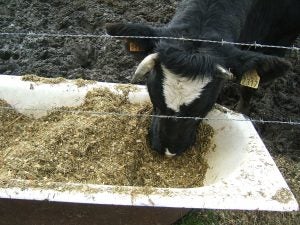Grass fed and grain fed beef are nutritionally equivalent. Okay, well not technically, but the differences are so minimal you would need to eat thousands of pounds of beef in a single sitting to have any real nutritional impact.
I know what you’re thinking. Challenge accepted, right? If you’re anything like me, you love to eat beef regardless of whether or not it was grass or grain finished. But according to surveys, a majority of people actually prefer the flavor of grain finished over grass finished.
Notice I say “finished” and not “fed.” You see, pretty much all beef cattle are grass fed — it all depends on how they’re finished after weaning that determines the labeling, however there is currently no federal standard that defines the term “grass fed.” Even if cattle are grain finished, they are still technically “grass fed” with access to unlimited forages like hay.

There is a myth that feeding cattle grains isn’t good for them, but this couldn’t be further from the truth. Corn is technically a type of grass, and if it caused health problems, farmers wouldn’t feed it to their animals! Common sense. Cattle have successfully eaten grains for decades with no ill effects.
Food corporations will stop at nothing to sell a product. Usually the label “grass fed” comes with pretty packaging and gorgeous images of happy cows on sunny days. They don’t make you think of cloudy days, rain, sleet, hail, tornados, or ice in winter. Although cattle generally seem to handle all different weather conditions with ease, have you ever stopped to think … what do grass fed cattle eat in the winter? Snow?
There’s always some type of farmer or rancher harvesting their grass-type forages so they can eat in winter; it isn’t just as simple as a pretty picture of cows on a field. (Although that is a lovely sight.)
So here’s the deal: It’s true that purely grass finished cattle do contain higher levels of omega-3’s, but grain finished produce higher levels of omega-6. Regardless, that level is low in the grand scheme of things. Beef is a nutritional powerhouse, packed full of healthy fats; an excellent source of various vitamins and minerals. These include vitamin B12, zinc, selenium, iron, niacin, and vitamin B6. It is also a great source for creatine, taurine, glutathione, and conjugated linoleic acid, to name a few. But the nominal differences between grass or grain aren’t enough to make a significant change on us as humans.
As always, the dose makes the poison, or the impact. Yes, it’s true beef is a healthy part of a balanced diet in moderation, however, when you compare the amounts of omega-3 or omega 6, it’s quite minute when compared to certain fish, like salmon. For example, a 3.5-ouce serving of grass finished beef averages about 80 milligrams while the same size serving of salmon has 1,000 to 2,000 milligrams of omega-3s. Moreover, the omega-3s in grass-finished beef are predominantly alpha-linolenic acid (ALA), not the types found in fish (EPA and DHA). ALA may have some health benefits of its own, and our bodies convert small amounts of it into EPA and DHA — but it can’t replace the omega-3s from fish.
You can read more about this here, with regards to info from Texas A&M university that have done the studies. I’d say eat more beef — the West wasn’t won on salad. But just know that beef is a nutritious choice, regardless of what it was fed.
Michelle Miller, the Farm Babe, is an Iowa-based farmer, public speaker and writer, who lives and works with her boyfriend on their farm which consists of row crops, beef cattle, and sheep. She believes education is key in bridging the gap between farmers and consumers.



